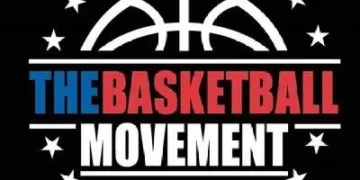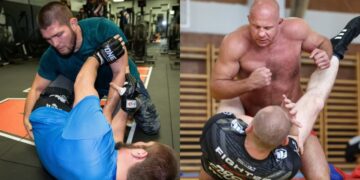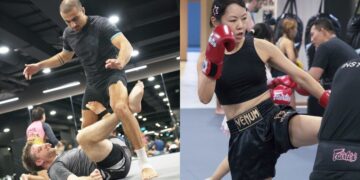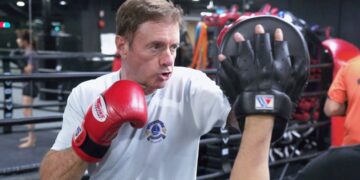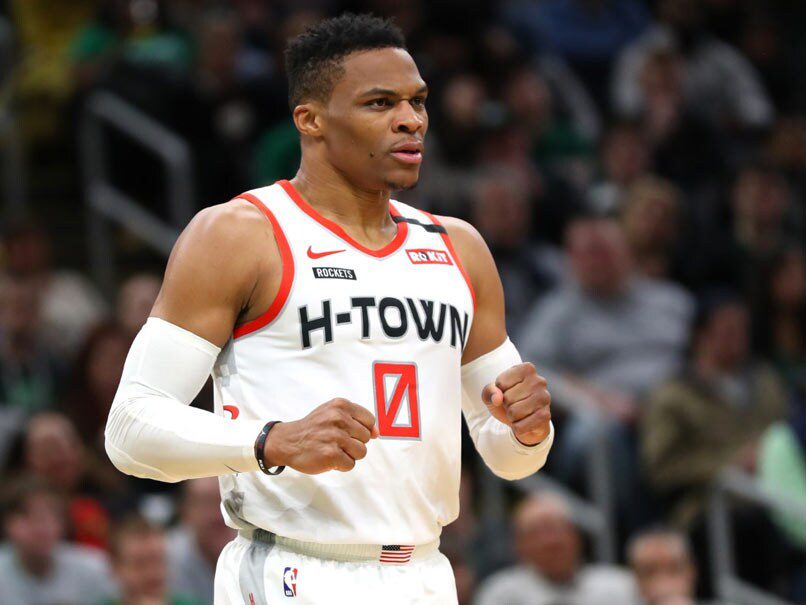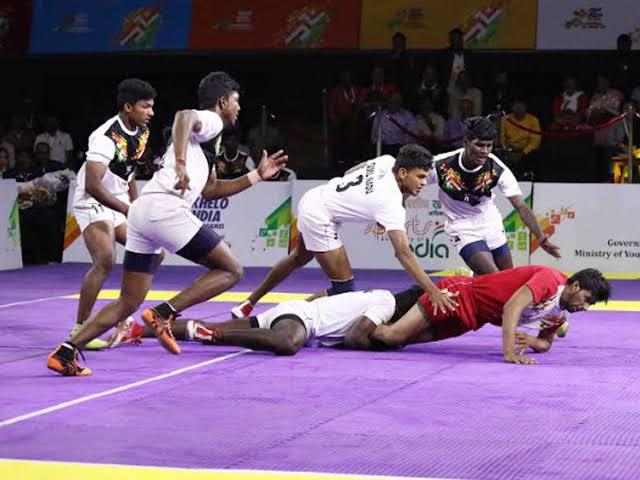Most people start martial arts for the physical benefits, to get fitter, stronger, or learn how to defend themselves. But talk to anyone who has been training for months or years, and you’ll often hear something different. They’ll tell you how martial arts makes them feel calmer, more confident, less stressed, and, in many cases, simply happier.
This isn’t just anecdotal. Science supports what martial artists have known all along: stepping onto the mats, tying your belt, or wrapping your hands isn’t only about physical conditioning, it’s about improving your mental well-being. From changes in brain chemistry to the sense of belonging that comes from training in a community, martial arts has powerful effects on happiness that go far beyond fitness.
Here’s a closer look at the scientific reasons why martial arts can help you live a happier life.
1) Movement And Mood: The Endorphin Effect

Martial arts delivers a full-body, purposeful workout that boosts endorphins harder and longer than routine gym sessions, lifting both body and mind.
When you train in martial arts, you’re not just moving; you’re moving with intensity, variety, and purpose. Research shows that moderate-to-high-intensity exercise releases endorphins, the “feel-good” chemicals that reduce pain and trigger a sense of euphoria. Martial arts training, with its mix of cardio, strength, and coordination, taps into this powerful natural antidepressant.
Unlike monotonous gym sessions, martial arts engages the whole body and keeps your mind present, which means those endorphins hit harder and last longer.
2) Stress Relief Through Controlled Combat

Martial arts offers a safe, structured outlet to release stress, lowering cortisol and turning daily tension into catharsis on the mats.
Punching pads, drilling takedowns, or rolling in Brazilian Jiu-Jitsu isn’t just physical. It’s cathartic. Studies in sports psychology suggest that physical outlets for stress, especially those involving striking or grappling, can significantly lower cortisol (the stress hormone).
Martial arts provide a structured and safe way to release pent-up tension. Instead of bottling up frustration from daily life, practitioners literally work it out on the mats.
3) The Flow State: Mindfulness In Motion
Happiness often comes from being fully present, what psychologists call “flow.” Martial arts naturally induce flow because training demands focus. Whether you’re defending a sweep, timing a kick, or practicing a form, you can’t be distracted by work emails or personal worries.
This immersion functions like mindful meditations, which has been shown to reduce anxiety and increase life satisfaction. Martial arts is essentially “active meditation” with the added benefit of fitness.
4) Confidence And Self-Efficacy

Mastering martial arts builds lasting confidence and self-belief, rewarding progress with dopamine and empowering you far beyond the gym.
Positive psychology highlights that confidence and a sense of mastery are linked to happiness. Every time you nail a new technique, whether it’s a jab–cross combination or your first successful guard pass, your brain gets a dopamine reward. Over time, this builds self-efficacy, the belief in your ability to handle challenges.
And unlike cosmetic goals in fitness, martial arts confidence runs deeper. Knowing you can defend yourself, stay calm under pressure, and handle adversity translates into daily life, making you feel more in control and, ultimately, happier.
5) Social Connection And Belonging

Martial arts fosters community and connection, turning training partners into lasting support systems that boost happiness and well-being.
Humans are wired for connection, and loneliness is one of the biggest predictors of unhappiness. Martial arts academies thrive on community. From bowing on the mats to helping a teammate drill, training builds bonds. Social neuroscience research shows that shared struggle and synchronized activities increase oxytocin, the “bonding hormone.”
Training partners often become friends, mentors, and support systems, which contributes significantly to long-term well-being.
6) Resilience And Emotional Regulation

Martial arts builds resilience by teaching you to face challenges, regulate emotions, and bounce back stronger both on and off the mats.
Life throws punches, metaphorical ones. Martial arts teaches you to take them, adapt, and come back stronger. Sports psychology research highlights that people who regularly engage in challenging physical activities develop higher resilience.
Learning to manage fear, frustration, and failure on the mats teaches emotional regulation, a key predictor of mental health and happiness.
The scientific reasons are clear: martial arts boost endorphins, reduce stress, create mindfulness, build confidence, foster connection, and enhance resilience. These aren’t temporary mood boosts; they’re building blocks for a happier, more balanced life.
FAQ: Martial Arts And Happiness
Q: Does Martial Arts Help With Anxiety?
A: Yes! Training reduces cortisol levels and improves mindfulness, which has been proven to lower anxiety over time.
Q: Which Martial Art Is Best For Stress Relief?
A: Any martial art can help, but striking arts like Muay Thai are particularly cathartic, while BJJ provides stress release through grappling and problem-solving.
Q: Do I Need To Be Fit First To Benefit?
A: Not at all! Martial arts adapts to all levels, and even beginners can reap the mental health benefits from day one.
Q: Is Martial Arts Safe?
A: Definitely. When taught in a supportive environment, martial arts is safe, empowering, and highly beneficial for mental well-being.
Train Martial Arts Now!
At Evolve MMA, we see this transformation daily. People come to train for fitness or self-defense, but what they often leave with is something deeper: a lighter mood, a stronger mindset, and a community that feels like family.
Happiness might not be the reason you first step onto the mats, but it’s often one of the greatest rewards of martial arts training!
Book your complimentary trial class with our World Champions below!
If you have any other questions regarding Evolve MMA and the programs we offer, you can get in touch with our membership executives at the following locations:
Evolve MMA (Orchard Central)
181 Orchard Road
#06-01 Orchard Central
Singapore 238896
Phone: Evolve MMA (KINEX)
11 Tanjong Katong Road
#02-52 KINEX
Singapore 437157
Phone: Evolve MMA (Star Vista)
1 Vista Exchange Green
#02-26A The Star Vista
Singapore 138617
Phone: (65) 6539 9590
Every few years, a new fitness trend captures attention. Whether it’s obstacle races, functional competitions like Hyrox, or the latest boutique workout, these programs bring excitement and variety. They can be fun, motivating, and effective…
Simple, portable, and brutally effective, the jump rope is a classic conditioning tool used by boxers, martial artists, and athletes across generations. It improves cardiovascular endurance, builds coordination, burns calories, and develops footwork in ways…
Kickboxing is one of the most dynamic and widely practiced combat sports in the world today. Known for its combination of powerful punches, sharp kicks, and fast footwork, it stands as a martial art that…
The recent bullying incident at Sengkang Green Primary School in Singapore, where a Primary 3 student was persistently targeted for nearly six months and her mother later received chilling death threats, has cast a spotlight…
Many working adults chase success in their careers but often do so at the expense of their health and peace of mind. Stress, long hours, and unhealthy coping habits like late-night drinks, endless scrolling, or…
Congrats on your decision to give martial arts a try. Prepare to be in the best shape of your life, physically and mentally. The hardest thing you have to do now is figure out which…
Ask any Singaporean about life in the city, and one theme pops up again and again: convenience. Whether it’s food delivery apps, cashless payment systems, or 24-hour services, Singapore is built around efficiency. The same…
Muay Thai is often called the art of eight limbs, using fists, elbows, knees, and kicks in fluid combinations. While power and technique get a lot of attention, rhythm is what ties everything together. Fighters…
In BJJ, the lasso guard is a variation of open guard that uses your leg to wrap around and control your opponent’s arm, “lassoing” their arm with your shin hooked behind their tricep and grip…
In martial arts, improvement does not come only from sparring or drilling techniques. Another powerful tool for growth is watching fight replays. Whether its a professional bout streamed worldwide or a recorded sparring session in…
For a long time, half guard was seen as a “last resort” position, a place you ended up when your guard was getting passed. But modern BJJ flipped the script. Today, the half guard is…
Boxing is often described as the “sweet science” because of the different styles fighters use inside the ring. Some prefer to brawl up close, relying on raw power and aggression, while others focus on speed,…





